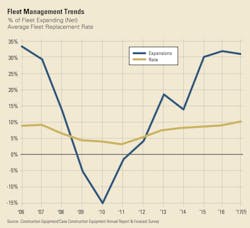Fleet Strength Builds
Construction markets just can’t seem to escape the gravitational pull of the Great Recession. Even a renewed federal transportation bill hasn’t provided the fuel needed to inspire the confidence to suggest that markets will recover strongly.
Equipment professionals, however, have not put plans on hold, at least not completely. They realize that the fleet needs to be ready to perform when their organizations beckon. For the second consecutive year, fleet strength has improved in the face of cautious expectations for growth. Managers are looking at various strategies, including how to integrate emissions-reducing technology, as they replenish fleet health.
Organizations that use construction equipment in their business reported that 2016 was a “good” year, continuing the rebound from the Great Recession. The 2016 business-year rating was short of expectations, however; managers last year forecast that 2016 would be “very good.” Fleet managers appear to have been overconfident in 2015 after several years of dismal business ratings, so they have tempered their forecast for this year, keeping it on level with 2016 at “good.”
CONSTRUCTION SECTOR REPORTS
Contract volume trends were also below expectations, although still in positive territory. Measured as a net percentage after those reporting decreases are subtracted from those reporting increases, the contract volume net was 15.8 percent, down from the 39.6 percent reported in 2015 and the 44.2 percent forecast for this year. The number is an unexpected hitch in the overall climb back from the languid results in 2011-2013.
Expectations for 2017 are a net of 25.9 percent, with 44.1 percent expecting increases in volume minus 18.2 percent expecting volume to fall. This may indicate that 2016 is a small stumble as the industry moves to full recovery, or it may be a return to the frustration with lagging government investment in infrastructure and haggling in Washington, D.C.
For the work that is available, managers expect solid growth in bid prices. In 2015, 62.9 percent of managers expected bid price increases in 2016. Subtracting the 4 percent who said prices would decrease left a net of 58.9 percent. Expectations for 2017 bid prices are comparable with a net of 55.5 percent: 59.8 percent expect bid price increases minus 4.3 percent that expect decreases.
Fleet Trends
Regardless of what is dragging down business ratings and volume, fleet progress continued last year. Fewer managers indicate uncertainty about Tier 4 machines, and fleet-replacement plans are kicking into gear. As uncertainty clears and fleets age, efforts to keep machines ready for work will include acquisition and expansion.
Fleets recorded the second consecutive year of expansion. In 2016, 40.6 percent of fleet managers said they increased the number of machines in their fleets. Subtracting the 8.8 percent who reported decreases, the net for 2016 is 31.8 percent, just slightly below the 33.1 percent net forecast.
Managers also expect to maintain expansion plans in 2017. The net forecast is 31.1 percent, with 36.8 expecting to increase fleet size, and 5.7 percent expecting a decrease.
A more telling metric for fleets coming out of the past few years is machine replacement rate. The 2016 rate hit expectations of 9.5 percent and is the second year above the healthy 9-percent mark. Expectations for 2017 cross the 10-percent mark, which hasn’t been seen since 2007.
Fleet health, which can only be helped by increasing replacement rates, improved slightly in 2016. The percentage of fleet managers labeling their fleet health as either “very good” or “excellent” totaled 47.4 percent, up from 45.6 percent in 2015. The number of “excellent,” however, dropped to 3.6 percent, a number not seen in recent years. On the other end of the spectrum, 11.6 percent of fleets are in “fair” or “poor” condition.
Acquisition strategies include purchasing outright followed by purchase by financing. Rental/purchase is a strategy used by 23.9 percent of fleet managers, the third straight year that percentage has grown.
Short-term rental dipped in 2016 to 16.4 percent from 18.3 percent in 2015. When asked to compare the use of short-term rental in 2016 to the previous year, 29.4 percent of respondents said they increased use versus 15.9 percent who said they decreased use.
